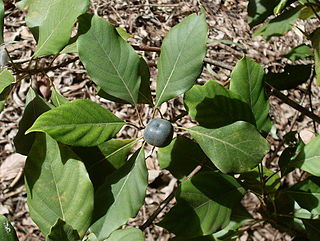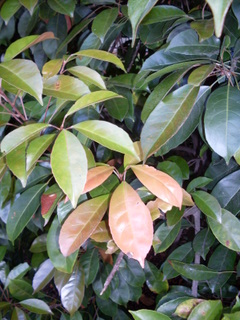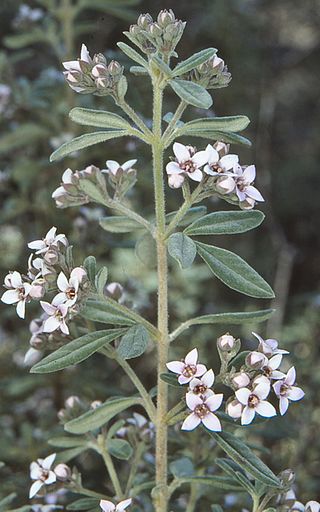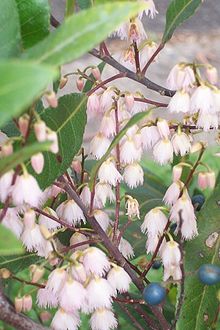
Elaeocarpus is a genus of nearly five hundred species of flowering plants in the family Elaeocarpaceae native to the Western Indian Ocean, Tropical and Subtropical Asia, and the Pacific. Plants in the genus Elaeocarpus are trees or shrubs with simple leaves, flowers with four or five petals usually, and usually blue fruit.

Elaeocarpus grandis, commonly known as caloon, white quandong, blue quandong, silver quandong, blue fig or blueberry ash, is species of flowering plant in the family Elaeocarpaceae and is endemic to eastern Australia. It is a large tree with buttress roots at the base of the trunk, oblong to elliptic leaves with small teeth on the edges, racemes of greenish-white flowers and more or less spherical blue fruit.

Elaeocarpus kirtonii, commonly known as silver quandong, white quandong, brown hearted quandong, brownheart, mountain beech, Mowbullan whitewood, pigeonberry ash, white beech or whitewood, is species of flowering plant in the family Elaeocarpaceae and is endemic to eastern Australia. It is a large rainforest tree with buttress roots, regularly toothed, narrow elliptic to narrow oblong leaves, racemes of white flowers and pale blue, oval fruit.

Elaeocarpus sedentarius, commonly known as Minyon quandong, is a species of flowering plant in the family Elaeocarpaceae and is endemic to a restricted area of New South Wales. It is a medium-sized to large tree with elliptic to egg-shaped leaves, racemes of whitish flowers and more or less spherical blue fruit.

Elaeocarpus holopetalus, commonly known as black olive berry, mountain blueberry, or mountain quandong, is species of flowering plant in the family Elaeocarpaceae and is endemic to eastern Australia. It is a shrub or small tree with regularly toothed, lance-shaped to egg-shaped leaves, racemes of white flowers and black, oval fruit.

Elaeocarpus obovatus, commonly known as hard quandong, blueberry ash, whitewood, grey carabeen, freckled oliveberry or gray carrobeen, is a species of flowering plant in the family Elaeocarpaceae and is endemic to eastern Australia. It is a tree with buttress roots at the base of the trunk, egg-shaped to lance-shaped leaves with the narrower end towards the base, racemes of white flowers, and blue, oval fruit.

Elaeocarpus eumundi, commonly known as Eumundi quandong, or smooth-leaved quandong, is a species of flowering plant in the family Elaeocarpaceae and is endemic to north-eastern Australia. It is a mid-sized tree with egg-shaped to lance-shaped leaves, racemes of cream-coloured flowers and blue fruit. It grows in rainforest from the Cape York Peninsula in Queensland to north-eastern New South Wales.

Philotheca buxifolia is a species of flowering plant in the family Rutaceae and is endemic to New South Wales. It is a shrub with more or less oblong leaves and solitary white to pink flowers arranged singly on the ends of branchlets.

Elaeocarpus costatus is a species of flowering plant in the family Elaeocarpaceae that is endemic to Lord Howe Island. It is a tree with lance-shaped to elliptic leaves with wavy-toothed edges, flowers in groups of eight to ten, and blue fruit.

Cryptandra amara, commonly known as bitter cryptandra or pretty pearlflower, is a species of flowering plant in the family Rhamnaceae and is endemic to eastern Australia. It is a densely-branched shrub with clustered, more or less linear to egg-shaped or elliptic leaves, and tube-shaped white flowers arranged on the ends of branchlets.

Zieria cytisoides, commonly known as the downy zieria, is a plant in the citrus family Rutaceae and is endemic to eastern Australia. It is a bushy shrub with three-part, clover-like leaves and small clusters of pale to deep pink flowers with four petals and four stamens.

Daviesia mimosoides, commonly known as blunt-leaf bitter-pea, narrow-leaf bitter pea or leafy bitter-pea, is a species of flowering plant in the family Fabaceae and is endemic to eastern continental Australia. It is an open shrub with tapering, linear, elliptic or egg-shaped phyllodes, and groups of orange-yellow and dark brownish-red to maroon flowers.

Elaeocarpus culminicola, commonly known as Michael's quandong, is a species of flowering plant in the family Elaeocarpaceae and is native to parts of Malesia and Australasia. It is a tree with wavy leaves with wavy or toothed edges, racemes of white, cream-coloured or pink flowers and more or less spherical fruit.
Elaeocarpus arnhemicus, commonly known as elaeocarpus, blue plum, bony quandony or Arnhem Land quandong, is species of flowering plant in the family Elaeocarpaceae and is native to northern Australia, New Guinea, Timor and certain other islands in the Indonesian Archipelago. It is a tree with narrow elliptic to lance-shaped or egg-shaped leaves with serrated edges, racemes of white or cream-coloured flowers and metallic blue fruit.
Elaeocarpus elliffii, commonly known as mountain quandong, is a species of flowering plant in the family Elaeocarpaceae and is endemic to north-east Queensland. It is a tree, sometimes with buttress roots at the base of the trunk, narrow egg-shaped leaves often with large domatia, flowers with five white petals with lobed tips, and more or less spherical fruit.
Elaeocarpus hylobroma is species of flowering plant in the family Elaeocarpaceae and is endemic to north-east Queensland. It is a small tree with elliptic to egg-shaped leaves with a few serrations near the tip, racemes of white flowers and dull blue, oval fruit.
Elaeocarpus johnsonii, commonly known as Kuranda quandong or Johnson's quandong, is species of flowering plant in the family Elaeocarpaceae and is endemic to north-east Queensland. It is a small to medium-sized tree, often with several main stems, elliptic to egg-shaped leaves with the narrower end towards the base, racemes of up to seven flowers, the petals with fringed lobes, and dark blue fruit.
Elaeocarpus linsmithii is a species of flowering plant in the family Elaeocarpaceae and is endemic to north-east Queensland. It is a shrub with oblong to elliptic leaves, white or pale green flowers and oval fruit.
Elaeocarpus miegei is a species of flowering plant in the family Elaeocarpaceae and is native to New Guinea, the Bismarck Archipelago, the Solomon Islands and the Tiwi Islands of the Northern Territory. It is a tall tree with lance-shaped to egg-shaped leaves with the narrower end towards the base, whitish to cream-coloured flowers and bright blue, elliptical fruit.
Elaeocarpus sericopetalus, commonly known as hard quandong, blueberry ash, hard duandong or northern quandong, is a species of flowering plant in the family Elaeocarpaceae and is endemic to Queensland. It is a tree, sometimes with buttress roots at the base of the trunk, relatively large lenticels, oblong to elliptic leaves, creamy-white flowers with five petals, and deep red to almost black fruit.















